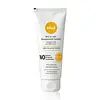What's inside
What's inside
 Key Ingredients
Key Ingredients

 Benefits
Benefits

No benefits
 Concerns
Concerns

No concerns
 Ingredients Side-by-side
Ingredients Side-by-side

Petrolatum
EmollientPPG-3 Benzyl Ether Myristate
EmollientOzokerite
Emulsion StabilisingCetearyl Alcohol
EmollientDiethylamino Hydroxybenzoyl Hexyl Benzoate
UV FilterBis-Ethylhexyloxyphenol Methoxyphenyl Triazine
Skin ConditioningCanola Oil
EmollientEthylhexyl Salicylate
UV AbsorberTitanium Dioxide
Cosmetic ColorantEthylhexyl Triazone
UV AbsorberCopernicia Cerifera Cera
EmollientTocopheryl Acetate
AntioxidantSilica
AbrasiveButyl Methoxydibenzoylmethane
UV AbsorberPetrolatum, PPG-3 Benzyl Ether Myristate, Ozokerite, Cetearyl Alcohol, Diethylamino Hydroxybenzoyl Hexyl Benzoate, Bis-Ethylhexyloxyphenol Methoxyphenyl Triazine, Canola Oil, Ethylhexyl Salicylate, Titanium Dioxide, Ethylhexyl Triazone, Copernicia Cerifera Cera, Tocopheryl Acetate, Silica, Butyl Methoxydibenzoylmethane
Ingredients Explained
These ingredients are found in both products.
Ingredients higher up in an ingredient list are typically present in a larger amount.
You might know this ingredient as Tinosorb S or Bemotrizinol. It is a UV filter that covers both UVA and UVB rays.
This ingredient has two peak UV absorption peaks ( 310 and 340 nm) and is able to absorb both UV-A and UV-B rays. This ingredient works by preventing UV rays from reaching and damaging your skin.
On top of that - it is highly photostable and helps prevent the photodegration of other sunscreen ingredients such as avobenzone.
Tinosorb S is allowed in the EU, Australia, and Asia. It is close to being approved by the FDA and we'll hopefully get this ingredient in the U.S. by late 2025.
Fun fact: Tinosorb S is the most effective UV absorber at maximum concentration (measured by SPF) permitted in the EU.
This ingredient is oil-soluble, so your oil-cleansers will take this right off at night.
Learn more about Bis-Ethylhexyloxyphenol Methoxyphenyl Triazine